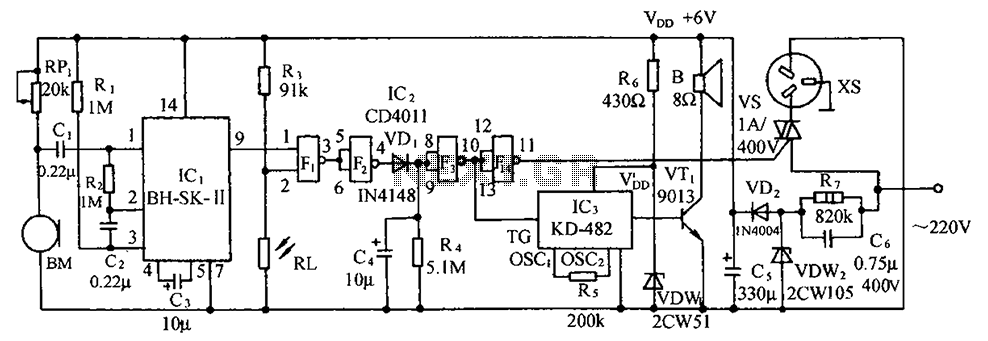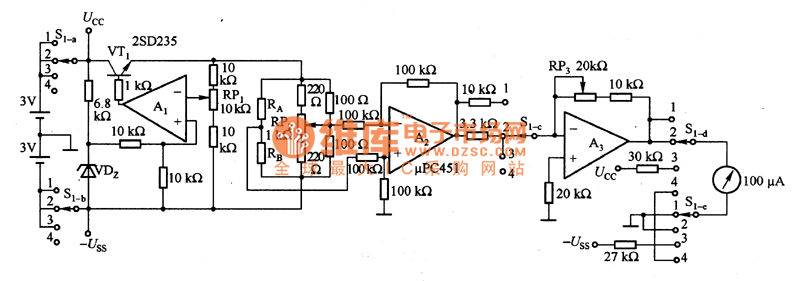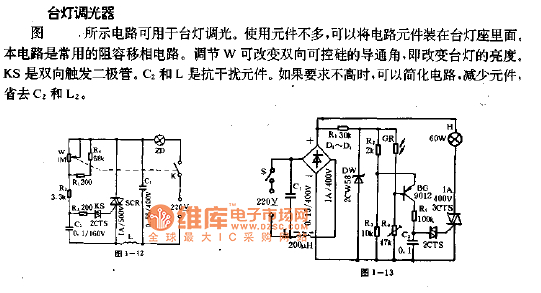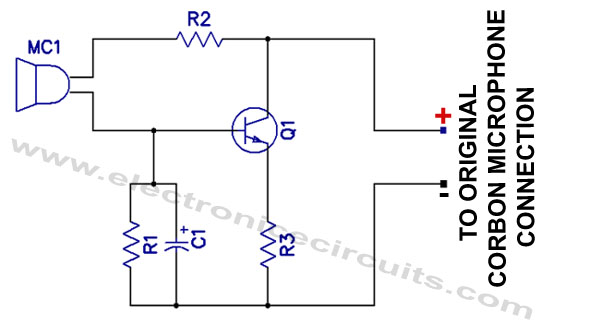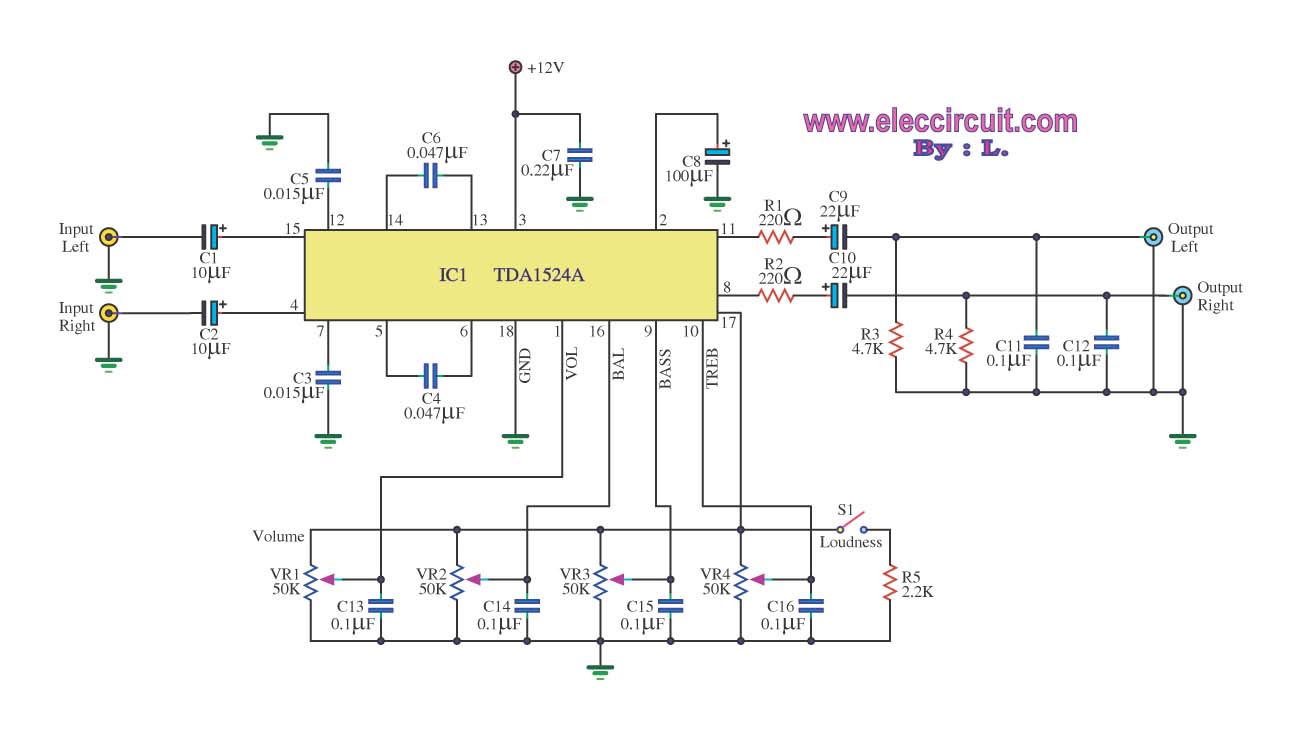
Blood pressure sensing circuit diagram BP01-type pressure sensor

This circuit utilizes a BP01-type pressure sensor and the MAX4472 operational amplifier. The BP01 pressure sensor is specifically designed for blood pressure detection and is primarily used in portable electronic sphygmomanometers. It features a precision thick film ceramic chip and is housed in a nylon plastic package, providing high linearity, low noise, and minimal external stress effects. The sensor includes internal calibration and temperature compensation to enhance measurement accuracy, stability, and repeatability, achieving an accuracy of 1% across the full scale, with a zero offset not exceeding 300 µV. The MAX4472 is a low-power operational amplifier chip from MAXIM, which integrates four operational amplifiers. In this system, one operational amplifier is configured as a constant current source to supply a steady current to the pressure sensor, while the other three operational amplifiers (B, C, and D) are arranged to form a differential amplifier circuit with a single-ended output, allowing for direct input to the ADC0 for blood pressure monitoring.
The circuit design incorporates a BP01 pressure sensor, which is optimized for blood pressure measurement applications. This sensor's construction ensures minimal noise and high linearity, essential for accurate readings in medical devices. The use of a thick film ceramic chip contributes to the sensor's durability and performance stability, while the nylon plastic packaging protects it from environmental stressors.
The MAX4472 operational amplifier is selected for its low power consumption, making it suitable for portable applications. The internal architecture of the MAX4472, featuring four op-amps, allows for versatile configurations. In this application, one op-amp is dedicated to providing a constant current to the BP01 sensor, ensuring that the sensor operates within its optimal range, regardless of variations in supply voltage or load conditions.
The differential amplifier configuration formed by op-amps B, C, and D enhances the signal from the pressure sensor by amplifying the difference between the input signals, effectively filtering out common-mode noise and improving the signal-to-noise ratio. The output from this differential amplifier is then conditioned for input to an analog-to-digital converter (ADC0), which digitizes the analog signal for further processing and display in a blood pressure monitoring system.
Overall, this circuit exemplifies a well-engineered solution for accurate blood pressure measurement in portable devices, ensuring reliable performance through careful selection of components and circuit configuration. As shown below, this circuit uses BP01-type pressure sensor and op amp MAX4472.BP01 type pressure sensor is specifically designed for the detection of blood pressure, mainly us ed in portable electronic sphygmomanometer. It uses precision thick film ceramic chip and nylon plastic package with high linearity, low noise and stress of the outside world of small features; the internal calibration and temperature compensation to improve the measurement accuracy, stability and repeatability, in full scale, accuracy of 1%, the zero offset is not greater than 300 V.MAX4472 MAXIMs a four integrated low-power operational amplifier amplifier chip. The system integrated operational amplifier A constant current source connected to provide a constant current of a pressure sensor, and the op amp op amp B C, D constitute a differential amplifier input, single-ended output amplifier circuit, direct input ADC0 DC component of blood pressure monitoring.
The circuit design incorporates a BP01 pressure sensor, which is optimized for blood pressure measurement applications. This sensor's construction ensures minimal noise and high linearity, essential for accurate readings in medical devices. The use of a thick film ceramic chip contributes to the sensor's durability and performance stability, while the nylon plastic packaging protects it from environmental stressors.
The MAX4472 operational amplifier is selected for its low power consumption, making it suitable for portable applications. The internal architecture of the MAX4472, featuring four op-amps, allows for versatile configurations. In this application, one op-amp is dedicated to providing a constant current to the BP01 sensor, ensuring that the sensor operates within its optimal range, regardless of variations in supply voltage or load conditions.
The differential amplifier configuration formed by op-amps B, C, and D enhances the signal from the pressure sensor by amplifying the difference between the input signals, effectively filtering out common-mode noise and improving the signal-to-noise ratio. The output from this differential amplifier is then conditioned for input to an analog-to-digital converter (ADC0), which digitizes the analog signal for further processing and display in a blood pressure monitoring system.
Overall, this circuit exemplifies a well-engineered solution for accurate blood pressure measurement in portable devices, ensuring reliable performance through careful selection of components and circuit configuration. As shown below, this circuit uses BP01-type pressure sensor and op amp MAX4472.BP01 type pressure sensor is specifically designed for the detection of blood pressure, mainly us ed in portable electronic sphygmomanometer. It uses precision thick film ceramic chip and nylon plastic package with high linearity, low noise and stress of the outside world of small features; the internal calibration and temperature compensation to improve the measurement accuracy, stability and repeatability, in full scale, accuracy of 1%, the zero offset is not greater than 300 V.MAX4472 MAXIMs a four integrated low-power operational amplifier amplifier chip. The system integrated operational amplifier A constant current source connected to provide a constant current of a pressure sensor, and the op amp op amp B C, D constitute a differential amplifier input, single-ended output amplifier circuit, direct input ADC0 DC component of blood pressure monitoring.
